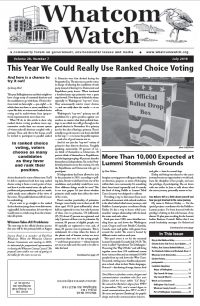1. Background: The Bellingham Municipal Code 13.16 outlines city regulations for 5G small cell installations. These were drafted in response to a 2018 City Council vote to support 5G installs. On January 14, 2019, new FCC regulations went into effect denying local municipalities the right to refuse 5G installations. So, Bellingham is set to proceed, yet there is an increasing outcry nationally and globally about the lack of scientific testing for safety, environmental effects, security and privacy issues. There is strong scientific basis for all these concerns. Some cities and states are suing against the FCC overreach. The Portland mayor refuses to proceed on the basis of health safety concerns, as well as FCC overreach.
What is your stance on supporting 5G installation in Bellingham?
My focus will be expanding Bellingham’s fiber optic infrastructure and increasing access to it. I think it is prudent to be patient and not rush into 5G installations while we learn more about health and security risks. We know that fiber optic cable is safe and our community needs better access, so my focus will be on meeting this need.
2. Background: The current Bellingham Comprehensive Plan envisions that future population growth will find housing in high-density urban villages. How best to provide additional housing in the city is an ongoing discussion. For example, new city code now permits backyard dwelling units.
Do you favor permitting multifamily housing, like triplexes, in areas of the city now zoned exclusively for single-family, detached homes?
Housing is no longer affordable in Bellingham and our voter approved Home Fund Levy will provide roughly 40 million dollars over the next 10 years to help us solve this problem. One thing that I have learned while serving on the Home Fund’s Loan Review Board is that we need to better leverage our tax dollars. This realization motivated me to create my Housing Innovation Project, please visit www.obrienformayor.org to watch our informational video. My Housing Innovation Project will create thousands of permanently affordable housing units in Bellingham over the next 10 years.
3. Background: Until 2012, the Mayor’s Neighborhood Advisory Commission, composed of representatives from every neighborhood, was by city code a party to the planning process which included review and comments on the city’s Comprehensive Plan and the individual neighborhood plans. Comments and recommendations from the Neighborhood Advisory Commission were submitted for consideration to the Planning Commission. In 2012, the city council, at the behest of the mayor, removed the Neighborhood Advisory Commission from the city’s planning process, thus eliminating neighborhoods from the planning process.
Would you be supportive of restoring, by city code, the role of the Mayor’s Neighborhood Advisory Commission in the process of updating the city’s comprehensive and neighborhood plans?
My Housing Innovation Project will require full engagement from a diverse group of stakeholders in our community including all of our neighborhood associations. Serving two terms on the Planning Commission has taught me that in order to successfully plan for growth, we need to do the extra work of getting our community involved. When drafting the community engagement portion of our Housing Innovation Project, I modeled the process after the collaborative community planning that allowed for Mercy Housing’s Eleanor Apartments to be built. When we work together the community benefits. This will be my approach.
4. Background: “Transportation is the largest source of greenhouse gas emissions in Bellingham, making up 32 percent of all community emissions.” (From the Bellingham Climate Action Plan.)
In recent years, Bellingham has made progress toward an active transportation network that helps reduce our carbon footprint as well as families’ transportation costs. More people are able to get where they need to go by walking, pedaling, and rolling (such as wheelchairs).
However, the connections for safe and active transportation are a long way from being complete, due to U.S. transportation planning that has for decades prioritized the movement of motor vehicles.
What transportation planning and funding solutions will you champion to accelerate both Bellingham’s reduction of carbon emissions and progress toward a safe and connected active transportation system for all ages and abilities?
The city of Bellingham’s vehicle fleet should be electric. I believe we need to provide more incentives to promote WTA ridership, and bicycle trips. We need to help convert existing buildings to provide secure and lighted bicycle storage areas and provide incentives for new development to promote multimodal transportation.
5. Background: Mayor Linville has proven to be very pro-development, and, despite some sporadic and largely bureaucratic interest in the topics, has not carved out a legacy of environmental stewardship in this era of species extinction and climate change. Some nations and municipal jurisdictions, in response to environmental chaos, are currently declaring a “climate emergency.”
If you were to use your position to declare a “climate emergency,” what specific actions would accompany it, and where would you foresee the most pressing need for change in order for Bellingham to survive the threats we are facing?
My top two priorities will be conserving energy and creating green energy. Many of our residents are unaware of the energy saving programs that are available to them, so we need to improve our outreach. For clean energy production we have an incredible opportunity at our waterfront to produce hydroelectric power. The city owns a large water pipe that supplied Georgia Pacific with millions of gallons of water, which we are no longer using. I want to build a hydroelectric power station at our waterfront and show the world we are serious about creating green energy.
6. Background: For businesses to be effective in our information-intensive economy, they need bandwidth delivered on a fiber-optic infrastructure, which provides speed and reliability. Bellingham city government has not yet made the commitment to pursue an effective fiber-optic infrastructure that is offered as an open-access network, giving co-ops, as well as telecoms, access. Doing so would attract new businesses and would provide a wider variety of internet options for existing businesses and residents. We have our neighbor, Mt. Vernon, as a model for success in doing this.
Do you feel that identifying the city’s current network, and adding to it as necessary to create a reliable fiber infrastructure is a priority?
This is absolutely a priority. We need to be prepared for the jobs of the future, and are already lacking in this area. The city has an existing fiber network, and the dark fiber could be leased to private industry to increase accessibility. As we continue to develop and maintain our existing utilities, we will ensure that conduit is installed so our fiber optic network can be expanded.





























